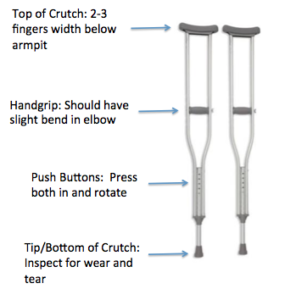Background
Crutches are used when a person is recovering from a lower body injury or surgery. The purpose of crutches are to ensure that a person can alter their weight bearing status based on diagnosis. Common ailments for the lower extremities that constitute the use of crutches are ligament injuries/repairs, muscle tears/repairs, and fractures.
Fitting
Crutch Height: Adjust the crutch height by pressing both buttons and rotating the bottom piece. Ideally, the top of the crutch should be two to three fingers width from the armpit. Once measured, rotate the bottom piece to lock the buttons in place.
 HandGrip: The crutch handgrip should be adjusted to show a slight bend in the patient's arm. Once it is set, tighten the adjusting bolts.
HandGrip: The crutch handgrip should be adjusted to show a slight bend in the patient's arm. Once it is set, tighten the adjusting bolts.
Test Fit: The patient should be able to lean forward comfortably with the bottoms outside and slight in front of their feet. If the crutches cause the person to stand completely erect, this means that the crutches are too long and need to be re-adjusted.
Buy on Amazon
Sizing and Safe Crutch Use
Safest Way to Sit and Stand with Crutches
Safety
Before using the crutches it is important to make sure:
- The crutches are correctly fitted
- All buttons are are engaged fully and are not pressed in
- The tips of the crutches are not completely worn at the bottom
- The handgrips are attached sturdily and do not move when pressure is applied through them
- No components are loose and both crutches are symmetrical
- Inspect both crutches and their parts for dents, cracks, or any irregularities
Stairs
When performing stairs, the crutches should always stay with and move with the injured lower extremity.
Ascending: When ascending the stairs the patient should always start by placing the non-injured lower extremity on the stair. The patient will then press through the non-injured lower extremity and move the injured lower extremity simultaneously with the crutches to the same stair. (Think "Good Goes Up First") This pattern is repeated until the stairs are completed.
Descending: When descending the stairs the patient should always start by moving the crutches to the lower stair. This makes the non-injured lower extremity do all the work and control the patient's weight. Once the crutches are on the stair, it is safe to move the non-injured lower extremity down to the same stair. (Think "Bad Goes Down First") This pattern is repeated until the stairs are completed.
It is important to remember not to allow the bottom of the crutch to be near the edge of the stair when ascending and descending for safety concerns.
References
Durable Medical Equipment. (2018). 1st ed. [ebook] Port Washington, N.Y.: Medical Depot, p.21. Available at: https://www.medline.com/media/catalog/Docs/MKT/LIT124R_CAT_Bath%20Safety%20and%20Walking%20.pdf [Accessed 16 Mar. 2018].
